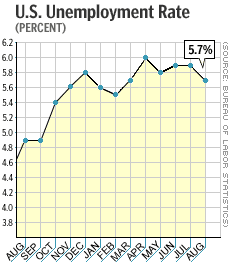NEW YORK (CNN/Money) - New weekly claims for jobless benefits in the United States rose last week, the government said Thursday, remaining above the benchmark 400,000 level, as the labor market's recovery progressed slowly from heavy job cuts last year.
The Labor Department said the number of Americans filing new claims for unemployment benefits rose to 426,000 in the week ended Sept. 7 from an upwardly revised 407,000 the prior week. Economists, on average, expected 400,000 new claims, according to Briefing.com.

It was the third straight week in which the number of claims exceeded 400,000, a benchmark level indicating weakness in the labor market.
"These are pretty awful numbers and, as far as we know, there are no mitigating circumstances," Ian Shepherdson, chief U.S. economist at High Frequency Economics Ltd., said in a note.
The report helped sink U.S. stock market futures, pointing to a negative opening on Wall Street. Treasury bond prices rose.
The four-week moving average of new jobless claims, which smoothes out fluctuations in the weekly data, rose to 409,500 last week -- the highest since June 8 -- from a revised 400,750 the prior week.
Continued claims, the number of people drawing benefits for more than a week, rose to 3.57 million in the week ended Aug. 31, the latest data available, from a revised 3.53 million the prior week.
The data followed last week's report by the Labor Department that the nation's unemployment rate dipped to 5.7 percent, news that cheered some on Wall Street but was received skeptically by some economists.
Most economists think the unemployment rate -- which is a lagging economic indicator, often rising even as the economy improves -- could rise as high as 6 percent before the labor market fully recovers.
"If this trend [in jobless claims] continues, September payrolls will surely fall outright, and the bizarre drop in the unemployment rate in August will reverse," Shepherdson said.
U.S. businesses cut more than 1.5 million jobs during a recession that began in March 2001, and lately have been able to get more production out of fewer workers, making them reluctant to increase hiring until they see a need to greatly expand production.
In a separate report, the Labor Department said its index of import prices rose 0.3 percent after rising 0.4 percent in July. Its index of export prices rose 0.1 percent after rising 0.3 percent in July.

|

